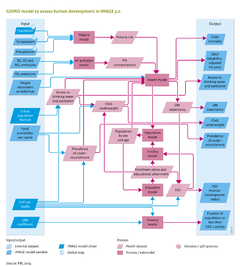Human development/Policy issues: Difference between revisions
Jump to navigation
Jump to search
No edit summary |
No edit summary |
||
| Line 1: | Line 1: | ||
{{ComponentPolicyIssueTemplate | {{ComponentPolicyIssueTemplate | ||
|Reference=PBL, 2009; PBL, 2012; | |Reference=PBL, 2009; PBL, 2012; | ||
|Description=The GISMO model has been used to evaluate various baseline scenarios, including that for the [[Roads from Rio+20 (2012) project|Rio+20]] study ([[PBL, 2012]]). In most of these scenarios, access to food, improved drinking water, basic sanitation and modern energy sources all increase significantly up to 2050. Yet, even under large increases in access levels, a significant proportion of the population will still be without adequate services, mainly in Sub-Saharan Africa and South Asia. By 2050, around 300 million people will live below a minimum level of food energy consumption, 250 million without sustainable access to safe drinking water, 1.4 billion without basic sanitation and 1.9 billion without access to modern energy sources for cooking and heating. Global child mortality is projected to reduce significantly, from 67 deaths per 1000 children born in 2010 to fewer than 45 by 2030 and 28 by 2050, with large improvements in all world regions (Figure below). To comply with the {{abbrTemplate|MDG}} on child mortality (MDG4), the under-five mortality rate should be reduced by two-thirds, between 1990 and 2015. Without new policies, this target will not be achieved, mainly due to persistent high levels of child mortality in Sub-Saharan Africa and South Asia (see also [[PBL, 2009]]). | |Description=The GISMO model has been used to evaluate various baseline scenarios, including that for the [[Roads from Rio+20 (2012) project|Rio+20]] study ([[PBL, 2012]]). In most of these scenarios, access to food, improved drinking water, basic sanitation and modern energy sources all increase significantly up to 2050. Yet, even under large increases in access levels, a significant proportion of the population will still be without adequate services, mainly in Sub-Saharan Africa and South Asia. By 2050, around 300 million people will live below a minimum level of food energy consumption, 250 million without sustainable access to safe drinking water, 1.4 billion without basic sanitation and 1.9 billion without access to modern energy sources for cooking and heating. Global child mortality is projected to reduce significantly, from 67 deaths per 1000 children born in 2010 to fewer than 45 by 2030 and 28 by 2050, with large improvements in all world regions (Figure below). To comply with the {{abbrTemplate|MDG}} on child mortality (MDG4), the under-five mortality rate should be reduced by two-thirds, between 1990 and 2015. Without new policies, this target will not be achieved, mainly due to persistent high levels of child mortality in Sub-Saharan Africa and South Asia (see also [[PBL, 2009]]). | ||
|Example=Policy interventions to decrease human health loss and child mortality rates can be classified as: | |Example=Policy interventions to decrease human health loss and child mortality rates can be classified as: | ||
# prevention through eliminating or reducing health risks; | # prevention through eliminating or reducing health risks; | ||
# treatment through investing in health systems to reduce deaths from a specific disease or due to a specific health hazard. | # treatment through investing in health systems to reduce deaths from a specific disease or due to a specific health hazard. | ||
Prevention in order to eliminate or reduce health risks is generally implemented by: | Prevention in order to eliminate or reduce health risks is generally implemented by (see table below): | ||
:* increasing access levels by lowering prices and investing in infrastructure; | :* increasing access levels by lowering prices and investing in infrastructure; | ||
:* improving the quality of access through, for example, household connections to the drinking-water supply and use of LPG or kerosene instead of using improved biomass stoves; | :* improving the quality of access through, for example, household connections to the drinking-water supply and use of LPG or kerosene instead of using improved biomass stoves; | ||
| Line 13: | Line 13: | ||
As a result of the policy interventions described above, global child mortality rates are projected to decline by 12% by 2030, and by more than 26% by 2050, in the ‘global technology’ scenario compared to the baseline scenario (Figure below). The additional policies in the second scenario are stylised in the sense that they are not calculated using the full modelling framework and, therefore, do not take into account all socioeconomic and environmental constraints. Under this scenario, child mortality delines by almost 25% by 2030 and by 34% by 2050, compared to the baseline scenario. However, in neither of the two scenarios MDG4 is achieved. | As a result of the policy interventions described above, global child mortality rates are projected to decline by 12% by 2030, and by more than 26% by 2050, in the ‘global technology’ scenario compared to the baseline scenario (Figure below). The additional policies in the second scenario are stylised in the sense that they are not calculated using the full modelling framework and, therefore, do not take into account all socioeconomic and environmental constraints. Under this scenario, child mortality delines by almost 25% by 2030 and by 34% by 2050, compared to the baseline scenario. However, in neither of the two scenarios MDG4 is achieved. | ||
}} | }} | ||
Revision as of 09:09, 20 May 2014
Parts of Human development/Policy issues
| Component is implemented in: |
|
| Related IMAGE components |
| Projects/Applications |
| Models/Databases |
| Key publications |
| References |
